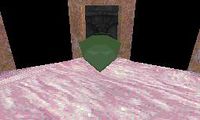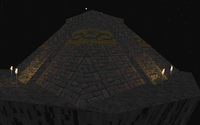Lore:Mantella
The Mantella was a massive green gem, a "Crux of Transcendence"[1] that contained the "heart", or life force, of the entity known to Tamriel as the Underking.[2] Twice, the Mantella was used to power the gigantic brass golem, Numidium—first by Tiber Septim when he conquered Tamriel, and again during the events of the Warp in the West.[2][3][4]
The Mantella was lost after Tiber Septim's conquests. For most of the Third Era, the Mantella was hidden on a plane of Aetherius known as the Mantellan Crux. It was later located by Nulfaga the sorceress and recovered by an agent of the Blades, which led directly to the Miracle of Peace.[2][4]
History[edit]
Second Era[edit]
—Daggerfall — A letter from a friend
Under the terms of the Armistice that brought Morrowind into the Empire in the late Second Era, Emperor Tiber Septim received the ancient Dwemer construct, Numidium. The Mantella was created by Imperial Battlemage Zurin Arctus as a replacement for Numidium's original power source, the Heart of Lorkhan.[2][3][5][6] The gem needed to be infused with the life force of a powerful being, so Arctus used his own[7] (though one source claims he trapped the heart of Wulfharth the Ash-King, another saying it cost Tiber Septim his own heart to create it;[8]:205 it has been suggested that both men may be mortal avatars[nb 1] of Lorkhan).[3] While the heart within the Mantella was "not exactly Lorkhan['s]",[3] it was sufficient to awaken Numidium, and with it Tiber Septim was able to conquer all of Tamriel.[2]
Numidium was destroyed not long after; some say Zurin Arctus became infuriated that the Emperor had begun using Numidium to crush the neutral royal families of Tamriel and enthrone those loyal to him. The Battlemage attempted to reclaim his heart but was killed in the attempt, and as a result he was transformed into the undead Underking.[7] In other accounts, it was an already-undead Underking who attacked Numidium.[3] Each account ends the same; Numidium was obliterated and its pieces scattered across Tamriel, and the Mantella was blown out of reality and into Aetherius, where it came to rest in a plane that would come to be known as the Mantellan Crux.[3][7][9]
In the years that followed, Tiber Septim sent out agents to recover the scattered pieces of Numidium, and they would become known as the Blades. Likewise, the Underking sent his forces to recover the Mantella.[7]
Third Era[edit]
In 3E 401, the Mantella's location was divined by the sorceress Nulfaga, the Dowager Queen of Daggerfall, in her astral travels. However, she went mad in 3E 403 following the death of her son, King Lysandus. Nulfaga retreated with the secret of the Mantellan Crux to Shedungent, her castle in the Wrothgarian Mountains.[2][8]
In 3E 405, Emperor Uriel Septim VII sent an agent of the Blades to investigate Lysandus' death, and why the King's spirit was haunting the city of Daggerfall. The agent discovered the king had been murdered and brought down the culprit, and also recovered the Totem of Tiber Septim—another artifact from Numidium, which allowed the bearer to control the automaton. In choosing a bearer for the Totem, The agent somehow gave it to seven different powers around the Iliac Bay region.[2]
Nulfaga, clear-headed with her son's shade at rest, then sent the agent to the Mantellan Crux to recover the gem.[10] Upon the Mantella's return to Tamriel, Numidium sprang to life once more; seven separate realities unfolded simultaneously across portions of Hammerfell and High Rock in 3E 417, an event known as the Warp in the West.[4][10] In the end, the Underking was able to finally reclaim his heart from the Mantella, resulting again in the destruction of Numidium and giving him the death he had sought for so long.[11]
See Also[edit]
- The Arcturian Heresy — an alternate account of events leading to the creation of the Mantella.
References[edit]
- ^ People of Morrowind — Various
- ^ a b c d e f g Events of Daggerfall
- ^ a b c d e f The Arcturian Heresy — The Underking, Ysmir Kingmaker
- ^ a b c The Warp in the West — Ulvius Tero
- ^ Kagrenac's Tools — Gilvas Barelo
- ^ Baladas Demnevanni's dialogue in Morrowind
- ^ a b c d The Mantella Revealed, Letter 2
- ^ a b The Daggerfall Chronicles — Ronald Wartow
- ^ Nulfaga's dialogue in Daggerfall
- ^ a b Journey to Aetherius quest in Daggerfall
- ^ Daggerfall ending cinematics

